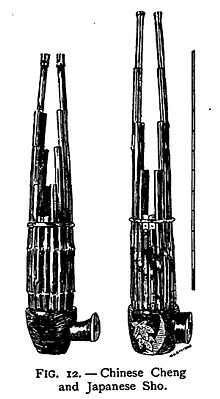Bernd Franke: in between (VI) for Sho and Sheng in three movements (2012)
BERND FRANKE (2012)
in between (VI) for Sho and Sheng in three movements
Auftragswerk von Naoyuki Manabe
UA/wp: 25.12.2012, Tokyo, Tokyo Opera Recital Hall
Naoyuki Manabe : Sho
Wu Wei: Sheng
_____
The shō (笙?) is a Japanese free reed musical instrument that was introduced from China during the Nara period (AD 710 to 794). It is modeled on the Chinese sheng, although the shō tends to be smaller in size. It consists of 17 slender bamboo pipes, each of which is fitted in its base with a metal free reed. Two of the pipes are silent, although research suggests that they were used in some music during the Heian period.

The instrument’s sound is said to imitate the call of a phoenix, and it is for this reason that the two silent pipes of the shō are kept—as an aesthetic element, making two symmetrical « wings ». Like the Chinese sheng, the pipes are tuned carefully with a drop of wax. As moisture collected in the shō’s pipes prevents it from sounding, performers can be seen warming the instrument over a small charcoal brazier when they are not playing. The instrument produces sound when the player’s breath is inhaled or exhaled, allowing long periods of uninterrupted play. The shō is one of the three primary woodwind instruments used in gagaku, Japan’s imperial court music. Its traditional playing technique in gagaku involves the use of tone clusters called aitake (合竹), which move gradually from one to the other, providing accompaniment to the melody.
A larger size of shō, called u (derived from the Chinese yu), is little used although some performers, such as Hiromi Yoshida, began to revive it in the late 20th century.
A detailed book in English on the shō and the gagaku (court orchestra music) it is associated with is titled Music of a Thousand Autumns: The Togaku style of Japanese Court Music by Robert Garfias.
The sheng (Chinese: 笙; pinyin: shēng; Zhuyin Fuhao: ㄕㄥ)[needs IPA]is a Chinese mouth-blown free reed instrument consisting of vertical pipes. It is a polyphonic instrument and enjoys an increasing popularity as a solo instrument.

It is one of the oldest Chinese instruments, with images depicting its kind dating back to 1100 BCE and there are actual instruments from the Han era that have been preserved today. Traditionally, the sheng has been used as an accompaniment instrument for solo suona or dizi performances. It is one of the main instruments in kunqu and some other forms of Chinese opera. Traditional small ensembles also make use of the sheng, such as the wind and percussion ensembles in northern China. In the modern large Chinese orchestra, it is used for both melody and accompaniment.
The sheng has been used in the works of a few non-Chinese composers, including Unsuk Chin, Lou Harrison, Tim Risher, Daníel Bjarnason, Guus Janssen and Christopher Adler. Some believe that Johann Wilde and Pere Amiot traveled to China and brought the first shengs to Europe in 1740 and 1777 respectively, although there is evidence that free reed musical instruments similar to shengs were known in Europe a century earlier.
Wikipedia